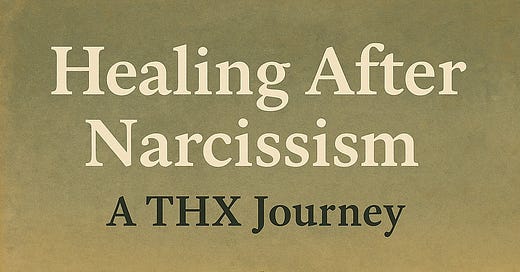Chapter 1 - Healing After Narcissism: A THX Journey
From THX Series Hub: The Narcissist’s Playbook & The Life After
Why I’m Finally Telling This Story
Author’s Note: This post contains descriptions of emotional, physical, and psychological abuse, including medical trauma, coercive control, and threats. Please take care as you read.
I was silent for a long time.
Not because I didn’t have anything to say. Not because I didn’t feel the need to scream or cry or rage or warn.
But because silence was safer.
Because being invisible was sometimes the only way to stay alive.
Because I had daughters to protect, a fragile thread of stability to maintain, and an entire life I was trying to unravel from the inside—carefully, strategically, without setting off another explosion.
I was married to a partner whose behavior aligned with narcissistic abuse dynamics for 25 years. The last three, we were separated in all the ways that mattered—emotionally, physically, spiritually—but still entangled by circumstance. Before that, I was raised by a mother with narcissistic traits and a father who stood by quietly, passively, while the emotional ground shifted under my feet.
I knew the look of manipulation disguised as affection.
I knew how words could be twisted until I doubted my own memory.
I knew what it felt like to walk on eggshells so long my feet forgot how to stand.
And I knew what it was like to almost die.
From anaphylaxis.
More than once.
Because she triggered it—whether through neglect or design, I may never fully know.
But I do know this: I still remember the feeling of my throat closing while she screamed at me. Not with concern, not with panic—but with blame.
This series isn’t about revenge.
It isn’t about her.
It isn’t even about what was done to me.
It’s about telling the truth—my truth.
And it's about showing how I survived it.
How I raised daughters in a house filled with fear and still taught them what love should feel like.
How I lived in secret. Cut off friends. Hid my location. Changed how I spoke, where I went, how I trusted—because survival required it.
It’s about what kept me going when I felt like I couldn’t.
And it’s about what finally helped me leave.
More than anything, this is a map.
For anyone who’s still in it.
For anyone who has gotten out but hasn’t healed.
For anyone who has no name for what they’ve endured, only the ache of walking on eggshells and the shame of wondering, “Why did I stay?”
I’m writing this using a framework I call THX—Transformative Human Experience.
It’s how I make sense of what I’ve lived.
It’s the lens that helped me name what was broken—and what needed rebuilding.
It’s how I went from enduring the unendurable to becoming someone I admire.
I’ll share more about that framework as we go, but for now, just know this:
This isn’t just about pain.
It’s about power.
Not the kind that hurts—but the kind that heals.
And if you’ve ever been afraid to speak, to leave, to believe you deserve better:
You’re not alone.
You never were.

Interpretation: The image captures the solitary but empowered path of post-abuse healing. The path curves, reminding us healing is never linear—but the glow ahead suggests hope, safety, and transformation through the THX journey.



